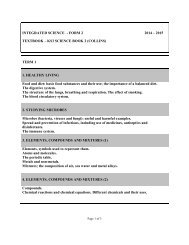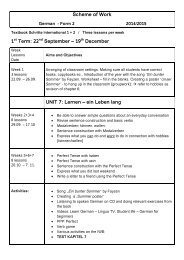Geography - Scheme of Work 2012-2013 Scheme of Work – Form 2 ...
Geography - Scheme of Work 2012-2013 Scheme of Work – Form 2 ...
Geography - Scheme of Work 2012-2013 Scheme of Work – Form 2 ...
- No tags were found...
Create successful ePaper yourself
Turn your PDF publications into a flip-book with our unique Google optimized e-Paper software.
<strong>Geography</strong> SOW <strong>–</strong> <strong>Form</strong> 2 St Joseph School Blata l-Bajda 2014-2015Topics: Life in The SaharaLesson Title Objectives ActivitiesLatitude andLongitudeHelp studentsidentify and locatedeserts around theworld using latitudeand longitude- Students are given 10minutes to explore the Atlas and identify what lines on maps show <strong>–</strong> note thenumbers, names, letters, degrees, etc.- They will be then given an empty world map where they will mark the important lines ot latitudeand longitude (7 lines <strong>–</strong> Equator, 2 tropics, 2 circles, Prime Meridian and Data line). Also the Poles.The location <strong>of</strong>Deserts in theWorldClimate andLandscape <strong>of</strong> theSaharaHelp studentsidentify and locatedeserts usinglatitude andlongitudeExplore the climaticand geomorphicfeatures <strong>of</strong> theSahara Desert- The teacher provides the students with atlases and the students have to find the world map whichshows the various deserts. Students list the deserts according to continent and investigate thecommon aspects regarding their location, (i.e. between 10⁰ and 30⁰ North and South <strong>of</strong> the Equatoron the western margins <strong>of</strong> continents), in relation to the latitudes and longitudes.- Another handout could include the following exercises:a) Teacher provides students with a list <strong>of</strong> places such as Timbuktu, Nouakchott,Marzuq, Agades,Gabarone and Medina. By the use <strong>of</strong> Google Earth or an atlas, the students have to fill in a table toprovide information on the continent, country, name <strong>of</strong> desert as well as latitude and longitude foreach named location.b) Identify the Equator on a map or globe and name a few countries that lie in the Northern andSouthern Hemisphere. They can locate the Sahara Desert on a map.- The teacher presents statistics <strong>of</strong> monthly average temperatures and rainfall for various locationswithin the Sahara Desert. <strong>Work</strong>ing in pairs the students examine these statistics to draw theirconclusions about the main climatic characteristics <strong>of</strong> hot deserts.- Teacher asks students to draw and describe their mental image <strong>of</strong> a desert. By using relevant photosand video clips the teacher then introduces the students to the local terms used namely erg, hamadaand reg.- The teacher then gives a list <strong>of</strong> terms related to desert landscapes namely sand, rocks, stones, vastplains, large towering cliffs, salt flats, dried clay or mud. The students have to research the internetto link these terms with related photos <strong>of</strong> the Sahara Desert and associate the above mentioned threetypes <strong>of</strong> desert landscape with the corresponding terms used.
















